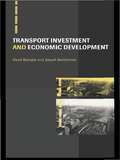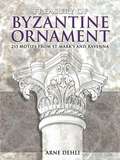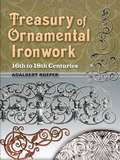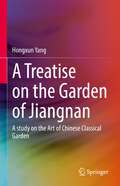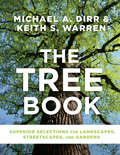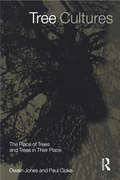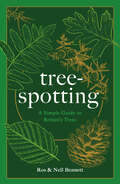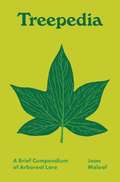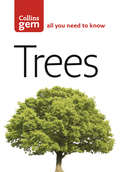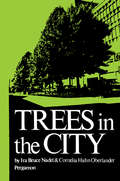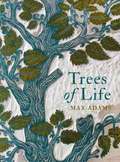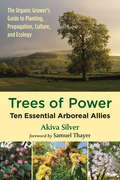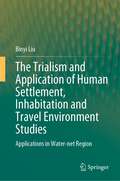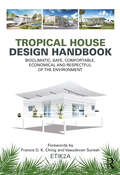- Table View
- List View
Transport Investment and Economic Development
by David Banister Joseph BerechmanA major concern of all decision makers has been to ensure that there are clear benefits from transport investment proposals. The travel time savings are clear, but the wider economic developments have presented enormous difficulty in terms of both theoretical arguments and empirical evidence. This book reviews the history of the debate and argues that the agenda has changed.These issues are presented together with a major analytical investigation of macroeconomic models, evaluation in transport and microeconomic approaches. The final part of the book presents a series of case studies for road, rail and airport investment schemes, particularly focusing on the economic development aspects.
Transport Matters: Integrated Approaches to Planning City-Regions (RTPI Library Series)
by Angela HullAddressing the principles of sustainability, spatial planning, integration, governance and accessibility of transport, this book focuses on the problem of providing efficient and low energy transport systems which serve the needs of everybody. It explores many of the new arguments, ideas and perceptions of mobility and accessibility in city-regions. Looking at evidence from Denmark, Sweden, The Netherlands, Germany and the UK, it considers the meaning of the key concepts of sustainable accessibility, the spatial planning model, and integrated territorial policies.
Transport Matters: Integrated Approaches to Planning City-Regions (RTPI Library Series)
by Angela HullAddressing the principles of sustainability, spatial planning, integration, governance and accessibility of transport, this book focuses on the problem of providing efficient and low energy transport systems which serve the needs of everybody. It explores many of the new arguments, ideas and perceptions of mobility and accessibility in city-regions. Looking at evidence from Denmark, Sweden, The Netherlands, Germany and the UK, it considers the meaning of the key concepts of sustainable accessibility, the spatial planning model, and integrated territorial policies.
Transport Policy and Planning in Great Britain (Natural and Built Environment Series #Vol. 5)
by Peter HeadicarTransport in the twenty-first century represents a significant challenge at the global and the local scale. Aided by over sixty clear illustrations, Peter Headicar disentangles this complex, modern issue in five parts, offering critical insights into: the nature of transport the evolution of policy and planning policy instruments planning procedures the contemporary agenda. Distinctive features include the links forged throughout between transport and spatial planning, which are often neglected. Designed as an essential text for transport planning students and as a source of reference for planning practitioners, it also furthers understanding of related fields such as urban and regional planning, geography, environmental studies and public policy. Based in the postgraduate course the author developed at Oxford Brookes University, this indispensable text draws on a lifetime of professional experience in the field.
Transportation & Land Use Innovations: When you can't pave your way out of congestion
by Reid EwingFirst published in 1997. Routledge is an imprint of Taylor & Francis, an informa company. This handbook introduces community leaders to an understanding of transportation mobility, offering suggestions to reduce congestion, automobile dependence, and vehicle miles of travel.
Transportation & Land Use Innovations: When you can't pave your way out of congestion
by Reid EwingFirst published in 1997. Routledge is an imprint of Taylor & Francis, an informa company. This handbook introduces community leaders to an understanding of transportation mobility, offering suggestions to reduce congestion, automobile dependence, and vehicle miles of travel.
Treasury of Byzantine Ornament: 255 Motifs from St. Mark's and Ravenna
by Arne DehliThe art of the Eastern Roman Empire and of its capital, Byzantium (Constantinople), found expression throughout the ancient world, particularly in Italian architecture. This superb archive of Byzantine ornament contains a wealth of decorative architectural elements derived from sixth- and seventh-century Italian buildings in Ravenna and in the Venetian church of St. Mark's.Depicted in more than 250 delicate line drawings are splendid perforated marble panels, intricately fashioned stone grilles and cornices, lavish candle brackets, elaborate stone mosaics for floors and ceilings, bronze window guards, as well as an abundance of decorative wreaths, rosettes, mouldings, and medallions.A multipurpose reference for students, artists, and designers, this archive of sumptuous, royalty-free designs will also serve as a rich source of inspiration for anyone working in the fine or applied arts.
Treasury of Ornamental Ironwork: 16th to 18th Centuries
by Adalbert RoeperSixty vintage black-and-white plates illustrate the history of German decorative ironwork from the16th to the 18th centuries. A hard-to-find celebration of the diversity and enduring beauty of Germany's handcrafted iron embellishments, this magnificent edition exhibits striking views of metal doors, balconies, window arches, gates, corner pieces, decorative accessories, and more, many wrought with gargoyles, human figures, and florals. A rich source of inspiration and an accurate, invaluable reference for art historians, architects, craftworkers, and designers.
A Treatise on the Garden of Jiangnan: A study on the Art of Chinese Classical Garden
by Hongxun YangThis book presents a study into the art of Jiangnan classical garden. Jiangnan (“the south of the Yangtze River”) refers to the water network region along the lower reaches of the Changjiang River (formerly known as Yangtze River), where Jiangsu Province Chinese gardens were primarily constructed during the 16th and 17th centuries of the later Ming and early Qing dynasties. The Jiangnan garden, an architectural space where artificial and natural elements are combined, represents the elite of classical Chinese gardens and serves as a prime exemplar for its northern counterpart, the Ming and Qing imperial gardens.The book pursues an interdisciplinary approach, combining historical information with case studies and other methods. Charts and pictures are used to supplement and reinforce the conclusions drawn from the macro narrative, enhancing the authenticity and readability of the historical monographs. It represents the first study of the classical art of landscape design in China, offering readers an insightful introduction.
The Tree Almanac 2024: A Seasonal Guide to the Woodland World
by Dr. Gabriel HemeryA wondrous seasonal journey through Britain and Ireland's trees.Uncover the majesty and minutiae of the arboreal world in forest scientist Dr Gabriel Hemery's illustrated month-by-month guide - including tree folklore and traditions, recipes and crafts, key dates, curiosities to spot, notes on wildlife and scientific marvels from the trees that surround us.From bare branches to budbursts, the first leaves to the first blossom and the great autumn colour-change, the Tree Almanac celebrates with joyous detail all that trees give us - whether ancient or urban - and inspires us to reconnect with nature. Foreword by Tracy Chevalier.
The Tree Book: Superior Selections for Landscapes, Streetscapes, and Gardens
by Michael A. Dirr Keith S. WarrenFrom two of the foremost names in horticulture, comes the authoritative guide for the best tree species and cultivars for the landscapes of today.
Tree Cultures: The Place of Trees and Trees in Their Place
by Paul Cloke Owain JonesThe relationship between nature and culture has become a popular focus in social science, but there have been few grounded accounts of trees. Providing shelter, fuel, food and tools, trees have played a vital role in human life from the earliest times, but their role in symbolic expression has been largely overlooked. For example, trees are often used to express nationalistic feelings. Germans drew heavily on tree and forest imagery in nation-building, and the idea of 'hearts of oak' has been central to concepts of English identity. Classic scenes of ghoulish trees coming to life and forests closing in on unsuspecting passers-by commonly feature in the media. In other instances, trees are used to represent paradisical landscapes and symbolize the ideologies of conservation and concern for nature. Offering new theoretical ideas, this book looks at trees as agents that co-constitute places and cultures in relationship with human agency. What happens when trees connect with human labour, technology, retail and consumption systems? What are the ethical dimensions of these connections? The authors discuss how trees can affect and even define notions of place, and the ways that particular places are recognized culturally. Working trees, companion trees, wild trees and collected or conserved trees are considered in relation to the dynamic politics of conservation and development that affect the values given to trees in the contemporary world. Building on the growing field of landscape study, this book offers rich insights into the symbolic and practical roles of trees. It will be vital reading for anyone interested in the anthropology of landscape, forestry, conservation and development, and for those concerned with the social science of nature.
Tree Cultures: The Place of Trees and Trees in Their Place
by Paul Cloke Owain JonesThe relationship between nature and culture has become a popular focus in social science, but there have been few grounded accounts of trees. Providing shelter, fuel, food and tools, trees have played a vital role in human life from the earliest times, but their role in symbolic expression has been largely overlooked. For example, trees are often used to express nationalistic feelings. Germans drew heavily on tree and forest imagery in nation-building, and the idea of 'hearts of oak' has been central to concepts of English identity. Classic scenes of ghoulish trees coming to life and forests closing in on unsuspecting passers-by commonly feature in the media. In other instances, trees are used to represent paradisical landscapes and symbolize the ideologies of conservation and concern for nature. Offering new theoretical ideas, this book looks at trees as agents that co-constitute places and cultures in relationship with human agency. What happens when trees connect with human labour, technology, retail and consumption systems? What are the ethical dimensions of these connections? The authors discuss how trees can affect and even define notions of place, and the ways that particular places are recognized culturally. Working trees, companion trees, wild trees and collected or conserved trees are considered in relation to the dynamic politics of conservation and development that affect the values given to trees in the contemporary world. Building on the growing field of landscape study, this book offers rich insights into the symbolic and practical roles of trees. It will be vital reading for anyone interested in the anthropology of landscape, forestry, conservation and development, and for those concerned with the social science of nature.
Tree-spotting: A Simple Guide to Britain's Trees
by Nell Bennett Ros BennettA beautifully illustrated guide to the marvellous and varied world of trees, and a fascinating introduction to the hidden secrets of 52 British species. Botanist and ecologist Ros Bennett has spent a lifetime helping people understand and identify plants and always hoped her daughter Nell would grow up to share her love of the natural world.During Nell's childhood years they spent much time exploring the local woods together. Here, Nell discovered the visual and tactile beauty of trees.In Tree-spotting, Ros and Nell have combined their backgrounds and talents to show you – through Ros's extensive experience and Nell's exquisite illustrations – how to identify 52 British trees simply and confidently.A beautiful and captivating insight into the wonderful world of trees, Tree-spotting burrows down into the history and hidden secrets of each species. It explores how our relationship with trees can be very personal, and will bring you closer to the natural world around you.
Treepedia: A Brief Compendium of Arboreal Lore (Pedia Books)
by Joan MaloofA captivating A–Z treasury for the tree hugger in all of usTreepedia is an entertaining and fact-filled illustrated compendium of tree lore. Featuring nearly 100 entries—on topics ranging from tree ecology and conservation to the role of trees in religion, literature, art, and movies—this enticing collection is a celebration of all things arboreal.In this charming book, Joan Maloof explains the difference between a cedar and a cypress, and reveals where to find the most remarkable trees on the planet. She tells the story behind the venerable Bodhi Tree, and describes peculiar species like baobabs and Fitzroya. Maloof profiles legendary conservationists such as Julia "Butterfly" Hill, John Muir, Wangari Maathai, and Ken Wu. She discusses reforestation, proforestation, emerald ash borers, the ents from The Lord of the Rings, culturally modified trees, the ill-fated and controversial Redwood Summer, and much more. The book's portable size makes it the perfect travel companion no matter where your love of the forest may lead you.With enchanting illustrations by Maren Westfall, Treepedia is a fun and informative book that is guaranteed to inspire anyone who has ever enjoyed a walk in the woods.Features a real cloth cover with an elaborate foil-stamped designUses 100 percent recycled, uncoated, wood-free paper
Treepedia: A Brief Compendium of Arboreal Lore (Pedia Books)
by Joan MaloofA captivating A–Z treasury for the tree hugger in all of usTreepedia is an entertaining and fact-filled illustrated compendium of tree lore. Featuring nearly 100 entries—on topics ranging from tree ecology and conservation to the role of trees in religion, literature, art, and movies—this enticing collection is a celebration of all things arboreal.In this charming book, Joan Maloof explains the difference between a cedar and a cypress, and reveals where to find the most remarkable trees on the planet. She tells the story behind the venerable Bodhi Tree, and describes peculiar species like baobabs and Fitzroya. Maloof profiles legendary conservationists such as Julia "Butterfly" Hill, John Muir, Wangari Maathai, and Ken Wu. She discusses reforestation, proforestation, emerald ash borers, the ents from The Lord of the Rings, culturally modified trees, the ill-fated and controversial Redwood Summer, and much more. The book's portable size makes it the perfect travel companion no matter where your love of the forest may lead you.With enchanting illustrations by Maren Westfall, Treepedia is a fun and informative book that is guaranteed to inspire anyone who has ever enjoyed a walk in the woods.Features a real cloth cover with an elaborate foil-stamped designUses 100 percent recycled, uncoated, wood-free paper
Trees (Collins Gem)
by Alastair FitterThe ideal portable companion, the world-renowned Collins Gem series returns with a fresh new look and updated material.
Trees in the City: Habitat: a Series of Texts on All Aspects of Human Settlements
by Ira Bruce Nadel Cornelia Hahn Oberlander Lesley R. BohmTrees in the City provides an introduction to the process of humanizing the cityscape and guide to planting trees in city conditions. This book focuses on four basic concepts. First, trees play an essential role in human's urban life. Second, people must become aware of the environmental, esthetic, social, and political importance of trees. Third, trees need to be integrated with the pattern and function of urban activity. Finally, the design, placement, and maintenance of trees on city streets are the responsibility of everyone in the community. The topics discussed include a short history of trees in the city; environmental and esthetic relation of trees, human, and the city; tree choices and features; and designing a city street—models, problems, and matrixes. This publication is beneficial to landscape architects and individuals interested in tree planting in urban areas.
Trees of Life
by Max AdamsAn informative, richly illustrated book about eighty of the world’s most important and remarkable treesOur planet is home to some three trillion trees—roughly four hundred for every person on Earth. In Trees of Life, Max Adams selects, from sixty thousand extant species, eighty remarkable trees through which to celebrate the richness of humanity’s relationship with trees, woods, and forests.In a sequence of informative and beautifully illustrated portraits, divided between six thematic sections, Adams investigates the trees that human cultures have found most useful across the world and ages: trees that yield timber and other materials of immense practical value, trees that bear edible fruits and nuts, trees that deliver special culinary ingredients and traditions, and trees that give us dyes, essences, and medicines. In a section titled “Supertrees,” Adams considers trees that have played a pivotal role in maintaining natural and social communities, while a final section, “Trees for the Planet,” looks at a group of trees so valuable to humanity that they must be protected at all costs from loss.From the apple to the oak, the logwood to the breadfruit, and the paper mulberry to the Dahurian larch, these are trees that offer not merely shelter, timber, and fuel but also drugs, foods, and fibers. Trees of Life presents a plethora of fascinating stories about them.
Trees of Power: Ten Essential Arboreal Allies
by Akiva SilverThe organic grower's guide to planting, propagation, culture, and ecology Trees are our allies in healing the world. Partnering with trees allows us to build soil, enhance biodiversity, increase wildlife populations, grow food and medicine, and pull carbon out of the atmosphere, sequestering it in the soil. Trees of Power explains how we can work with these arboreal allies, specifically focusing on propagation, planting, and individual species. Author Akiva Silver is an enthusiastic tree grower with years of experience running his own commercial nursery. In this book he clearly explains the most important concepts necessary for success with perennial woody plants. It’s broken down into two parts: the first covering concepts and horticultural skills and the second with in-depth information on individual species. You’ll learn different ways to propagate trees: by seed, grafting, layering, or with cuttings. These time-honored techniques make it easy for anyone to increase their stock of trees, simply and inexpensively. Ten chapters focus on the specific ecology, culture, and uses of different trees, ones that are common to North America and in other temperate parts of the world: Chestnut: The Bread Tree Apples: The Magnetic Center Poplar: The Homemaker Ash: Maker of Wood Mulberry: The Giving Tree Elderberry: The Caretaker Hickory: Pillars of Life Hazelnut: The Provider Black Locust: The Restoration Tree Beech: The Root Runner Trees of Power fills an urgent need for up-to-date information on some of our most important tree species, those that have multiple benefits for humans, animals, and nature. It also provides inspiration for new generations of tree stewards and caretakers who will not only benefit themselves, but leave a lasting legacy for future generations. Trees of Power is for everyone who wants to connect with trees. It is for the survivalist, the gardener, the homesteader, the forager, the permaculturist, the environmentalist, the parent, the schoolteacher, the farmer, and anyone who feels a deep kinship with these magnificent beings.
Trends in Urban Design: Insights for the Future Urban Professional (Contemporary Urban Design Thinking)
by Rob RoggemaUrban planning practice will undergo significant changes in the upcoming decades, due to major changes and challenges the world has to deal with, such as loss of biodiversity loss, climate change impacts, agricultural transformation, water management issues and health. The way the urban professional has to relate to this new order is explored in this book by collecting a series of conversational chapters with local, regional, national and international experts in the fields of urban planning and design, urban and building development, building and construction industry, architecture, governments and academia. The unification of a desirable future with real world processes such as economic and decision-making practice is key. Moreover, the attitude of the future urban professional will more and more shift from an expert in a specific field to a communicative advisor in complex processes.
The Trialism and Application of Human Settlement, Inhabitation and Travel Environment Studies: Applications in Water-net Region
by Binyi LiuThis book studies human settlements in China in terms of Human Settlements Trialism in 5 typical human settlement types: river valleys, water networks, hills, plains, and arid areas. Focusing on 3 elements of Trialism—(1) natural and constructed environments, resources, and visual landscapes in human settlements background; (2) survival strategies, customs, culture, and values in human settlements activity; and (3) the layout of time and space as well as the planning and design of the urban, the country, and the wilderness in human settlements construction—the book analyzes the evolution of human settlements and predicts future trends. Presenting academic researchers and graduate students in various fields with insights from landscape architecture, urban planning, architecture, geography, forestry, art, and psychology, the study discusses the principles of interactive physiological thinking and systematically theoretical philosophy related to professional physiology, planning and design principles, and traditional and modern methods and technologies in urban and rural construction. The innovative multi-discipline study promotes the planning and design of 5 types of human settlement, which is helpful to the judgment of value, activity rule, and living style of human settlements, and also discusses the development of human settlements in the new millennium.
The Triumph of Seeds: How Grains, Nuts, Kernels, Pulses, and Pips Conquered the Plant Kingdom and Shaped Human History
by Thor HansonAs seen on PBS's American Spring LIVE, the award-winning author of Buzz and Feathers presents a natural and human history of seeds, the marvels of the plant kingdom"The genius of Hanson's fascinating, inspiring, and entertaining book stems from the fact that it is not about how all kinds of things grow from seeds; it is about the seeds themselves." --Mark Kurlansky, New York Times Book ReviewWe live in a world of seeds. From our morning toast to the cotton in our clothes, they are quite literally the stuff and staff of life: supporting diets, economies, and civilizations around the globe. Just as the search for nutmeg and pepper drove the Age of Discovery, coffee beans fueled the Enlightenment and cottonseed sparked the Industrial Revolution. Seeds are fundamental objects of beauty, evolutionary wonders, and simple fascinations. Yet, despite their importance, seeds are often seen as commonplace, their extraordinary natural and human histories overlooked. Thanks to this stunning new book, they can be overlooked no more. This is a book of knowledge, adventure, and wonder, spun by an award-winning writer with both the charm of a fireside story-teller and the hard-won expertise of a field biologist. A fascinating scientific adventure, it is essential reading for anyone who loves to see a plant grow.
Tropical House Design Handbook: Bioclimatic, Safe, Comfortable, Economical and Respectful of the Environment
by Etik2aPacked with accessible information, this book covers all the technical and practical aspects of home design in tropical environments. . It begins by outlining the prerequisites needed to understand the issues involved (climate, heat, thermal comfort, etc.) and discusses the solutions offered by traditional housing. It then identifies current solutions for protecting buildings and their occupants from solar radiation and external heat, while promoting bioclimatic and environmentally friendly approaches. . The economic viability of the solutions identified is discussed, as are the advantages and disadvantages of the materials, depending on the context and standards in force. . Numerous examples illustrate how buildings can be adapted to local realities, from the avant-garde creations of Jean Prouvé to those of today’s architects who are committed to sustainable development, as well as specific projects incorporating the recommendations made in this book. More than 460 photos, drawings, diagrams, tables, maps, house plans, logos and pictograms illustrate this reference work for all those involved in construction in tropical regions, particularly students in the field and, more generally, anyone – from professionals to private individuals – looking for useful information on this subject.
Tropical House Design Handbook: Bioclimatic, Safe, Comfortable, Economical and Respectful of the Environment
by Etik2aPacked with accessible information, this book covers all the technical and practical aspects of home design in tropical environments. . It begins by outlining the prerequisites needed to understand the issues involved (climate, heat, thermal comfort, etc.) and discusses the solutions offered by traditional housing. It then identifies current solutions for protecting buildings and their occupants from solar radiation and external heat, while promoting bioclimatic and environmentally friendly approaches. . The economic viability of the solutions identified is discussed, as are the advantages and disadvantages of the materials, depending on the context and standards in force. . Numerous examples illustrate how buildings can be adapted to local realities, from the avant-garde creations of Jean Prouvé to those of today’s architects who are committed to sustainable development, as well as specific projects incorporating the recommendations made in this book. More than 460 photos, drawings, diagrams, tables, maps, house plans, logos and pictograms illustrate this reference work for all those involved in construction in tropical regions, particularly students in the field and, more generally, anyone – from professionals to private individuals – looking for useful information on this subject.
